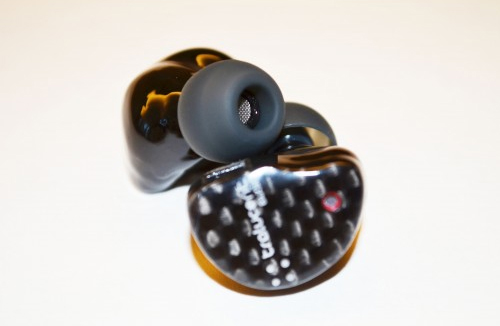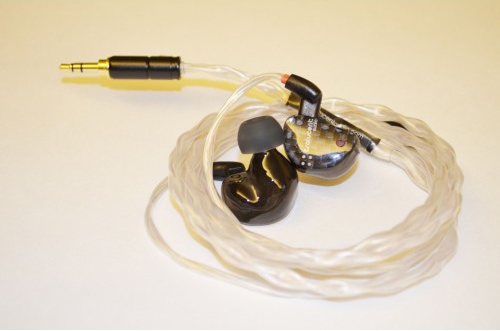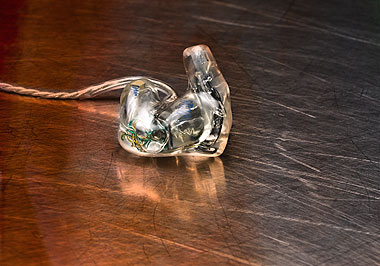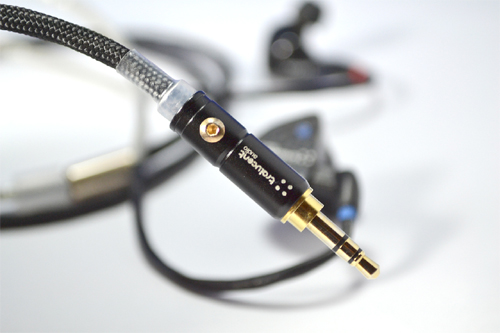|
|
You are reading the older HTML site
Positive Feedback ISSUE 72
tralucent audio 1plus2 In-Ear Monitors as reviewed by Amos Barnett
I had a funny experience at a headphone festival in Tokyo. For those who are not familiar with it, a small second-hand shop decided to start its own event dedicated to headphones and personal audio, and it turned into the largest even of its kind in the world, with four whole floors of companies presenting products. At this particular show, companies from the US and Europe have been making their way over gradually and signing up distributors. One of them was JHAudio. Jerry Harvey, the "JH" behind JH Audio, and who started the custom IEM revolution himself, was present. As I approached and introduced myself, he offered to… stick something in my ears. Considering he is tall and imposing with a tattooed body—particularly disconcerting for Japanese people, who usually associate tattoos with criminals, though I'm not Japanese – it was an unexpected moment. He is, of course, very friendly, but that was unexpected. I ended up getting a pair of JH13 Frequphase customs. JHAudio wasn't the only custom IEM company present at the show. With top multi-driver custom IEMs costing between $1000 and $2000, they have long been considered the epitome of isolated portable listening, despite their original purpose being for state musicians and, before that, hearing aids. But what is significant about high-end IEMs is that a number of companies are coming out with top-of-the-line models that are not custom-moulded. Shure recently announced their $999 SE846 with its high-tech multi-plate bass filter. Ultimate Ears have their UE900, and Sony have created successors to their $400-$500 flagships, DITA Audio in Singapore have their Van Den Hul-cabled The Answer, and AKG created their K3003. Out of seemingly nowhere—well, OK, out of Hong Kong in fact – came a completely unknown company with a completely unknown IEM: The Tralucent Audio 1plus2. Enthusiasts who got hold of a pair waxed lyrical. Arguments started and flame wars erupted. Who is Tralucent Audio guy, and how the heck can his first product be so good? Can this really beat a custom IEM from Ultimate Ears or JH Audio? Etc. Said Tralucent Audio guy is Gavin Chiu. Speaking to him on the phone, one has the mental image of a middle-aged British man, but Gavin was born in Hong Kong. The thick accent comes from having grown up in England and, having worked there and retired, he has since returned to his ancestral home. Possessed of a satisfyingly high-end hi-fi system, Gavin took an interest in headphones to take with him when he travelled, but was greatly disappointed with the sound quality from what was available. IEMs especially disappointed him, something which I am entirely sympathetic to. So he set about starting a company to make a pair of IEMs that satisfied his particular goals, primarily that they should present the music in a way that sounded as far as possible like his home audio system.
The world of IEMs is interesting, in that the issues Gavin and others have with existing designs are, in many respects, similar to those with speakers. What put me off in-ear monitors for quite a long time was that their rendering of instruments was awful and unnatural, especially percussion, which sounded flat. It wasn't until I spoke to Jerry Harvey at one of the Tokyo shows that I came to understand the reasons for this. That reason is phase: The alignment of the sound waves coming from the drivers that causes them to cancel each other out. It turns out that this is a huge problem with IEMs, much more so than with speakers. Like high-end speakers that offset the drivers, with some further back than the others to improve the phase response, IEM manufacturers have started to do a similar thing inside IEMs to fix this problem, such as in JHAudio's improved Freqphase series. Even less expensive models such as Sony recent XBA series have been designed with it in mind too.
If you look inside a pair of Jerry Harvey's IEMs, the drivers are attached to tubes of specific lengths for this purpose. In the case of the Tralucent 1plus2s, Gavin didn't want to use tubes, to avoid any effect on the sound they caused, so he uses a dual balanced armature driver which sits all the way forward inside the IEM. Behind that is a single dynamic driver, more like the ones we see in headphones and speakers. The design is not dissimilar to concentric speakers. Like speakers, in-ear monitors can have different types of drivers, though the amount of variation isn't as great as in the world of speakers. The two main kinds are very small dynamic drivers, similar to those in regular headphones, and balanced armature drivers, which originate from hearing aids and look like a tiny metal box with a hole or tube on one end. In-ear monitors can have one, or the other, or both in a variety of combinations. The limitation is that they have to come out a hole that is smaller than the tip that inserts into your ear, whether that is the tip of an acrylic custom-mould or nozzle, upon which a usually silicon tip is placed. In the case of the 1plus2, it is an acrylic nozzle shaped to take a regular silicon tip. At the end of that nozzle is a metal screen, immediately behind which is a dual-balanced armature drive unit, the "plus2" in the name. Further back into the earpiece is a dynamic driver, the "1", behind which is an amount of damping material, in a manner similar to what speakers have. That has a back-port, visible on the earpieces and colour-coded in blue or red, for left and right respectively. To finish it all off, the back plate is made from carbon fibre. In true audiophile fashion, the IEMs can be ordered with a stock cable, or the $1300 Uber cable. Hand made by a single person from very high quality silver/gold wire, it gives the IEMs a warmer and smoother sound than the stock cable, but has to be treated with care not to be bent excessively. This meant I had to be more cautious than usual when handling it. My review loaner had only a shallow notch upon which the silicon tip sat, resulting in the tips falling off in my bag or, a bit more scarily, in my ears. Gavin tells me that he has had the design of the latest ones modified with a deeper notch to prevent this happening. By default, two kinds of tips are provided, with the softer white ones from Ortofon. They are a fairly common size, so that tips for most regular IEMs from Sony and others should work, and will make for cheap experimentation as every design affects the resulting sound a little differently. However, given both my and Gavin's preference for the soft Ortofon ones, I wrote my notes using those exclusively. The first thing one tends to notice with the 1plus2s when listening is similar to that of Sennheiser's HD-800 headphones: space. IEMs, by nature, cannot have a soundstage as such, as our ear's pinna is bypassed, but as far as is possible, they give a sense of space. The mental trick of this is the result of the mid-range being slightly recessed compared to the other frequencies, helped by a peak in the treble that gives instruments a sense of "air," and thus, space.
Percussion, however, sounds like actual percussion all the way from bass drums up to cymbals, with the realism of the presentation scaling with better equipment too. Out of my portable rig, which consists of an Astel and Kern AK100 player, with or without a better portable amplifier attached, I had concerns about the treble. Plugging them into my far more capable home rig instead, and my concerns were relieved—it was merely the IEMs themselves revealing the limitations of my portable system. In fact, my most enjoyable listening was done with Woo Audio's great all-rounder, the WA7, fed by an Audio-gd NOS-1704 DAC. The narrower soundstage of this (compared to my main DAC) wasn't an issue with IEMs that don't have a soundstage as such. Likewise, when I broke out more complex and demanding music, such as Friday Night in San Francisco, a slight blurring when playing directly from the AK100 was readily relieved by a better amp, in my case a Headamp Pico Power. This placed the 1plus2s in my mind as more demanding IEMs, albeit a trait we'd normally associate with insensitive planar headphones, if not Sennheiser's flagship HD-800s. On "Baby Please Don't Go" by the Cowboy Junkies, from Whites Off The Earth Now, the bass guitar line was strong without interfering with the mids or treble. The track has the guitar less forward than some headphones, making it less intense than I'm used to in some cases. Raising things up a bar with a binaural album like C.C. Colletti's Bring it On Home from Chesky Records, the impression of space is uncanny. The illusion is only broken by the cymbals, which are a bit splashy, and a touch of harshness present with the vocals, something bettered only newer IEMs such as the JHAudio Roxanne that have more drivers for the treble. Their capability was equally apparent in revealing the extended bass of the ALO Audio Reference 20 interconnects when I switched to them on my (albeit inappropriate for IEMs) ALO Audio Studio Six amplifier. Overall, through careful tuning of their frequency response, the Tralucent 1plus2s, while not capable of instrument delineation, do a remarkable job of giving the music a sense of space, where it should not be able to through an in-ear monitor. While not the same, they often reminded me of Sennheiser's HD-800s which do a similar, remarkable job of presenting the music in a 3D way without using speakers. Gavin explained that he voiced them to sound as close as possible to hi-fi system where, when the speakers are set up properly, the singer is in the middle and the rest of the equipment disappears. What is most remarkable about these IEMs is not just their capability to deliver a spacious sound, but the fact that they are not the result of an engineer's efforts, but rather a single man determined to own a pair of IEMs that could do suitable justice to the music he liked while he was travelling. Indeed on Head-Fi.org they set a high bar amongst community members for a universal fit in-ear monitor at the price one would normally pay for a custom-moulded pair (which are normally for stage musicians, but are increasingly becoming popular amongst headphone audiophiles). I wouldn't be surprised if they were responsible for the recent trend amongst custom in-ear manufacturers to make universal fit versions of their custom-mould products. With the increasing number of high-end in-ear monitors becoming available, and equally very capable portable digital audio players from Iriver, Sony, and others, Gavin intends to release a new model of IEM that should raise the bar even further. I'm very much looking forward to that! Amos Barnett
Tralucent Audio 1plus2s
Tralucent Audio
|












